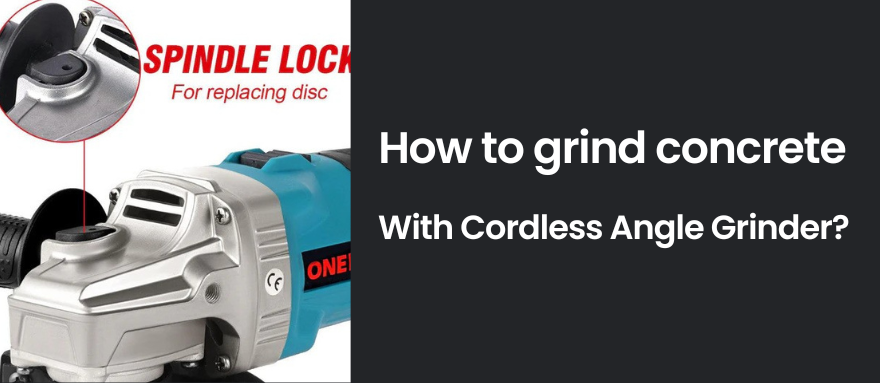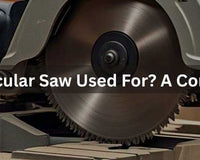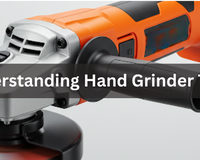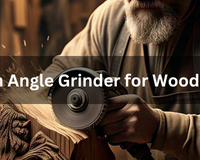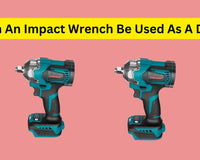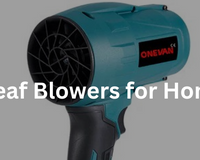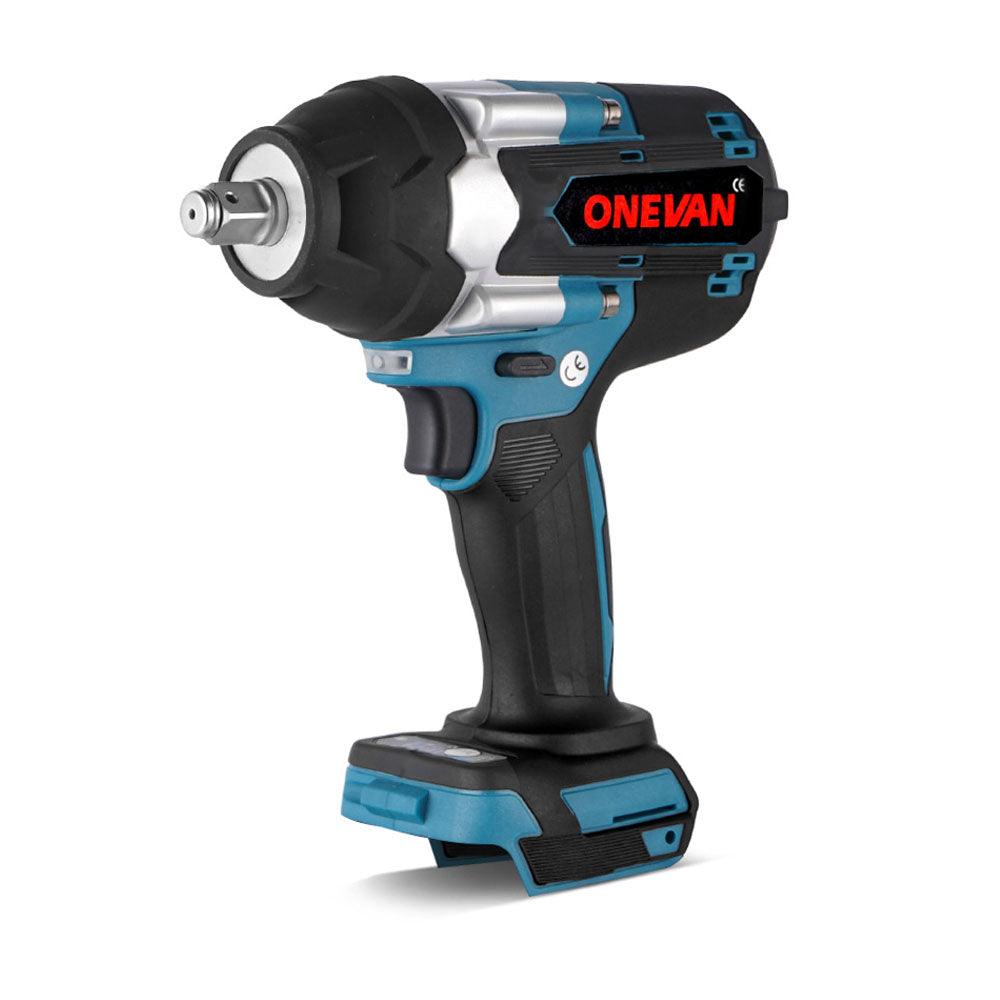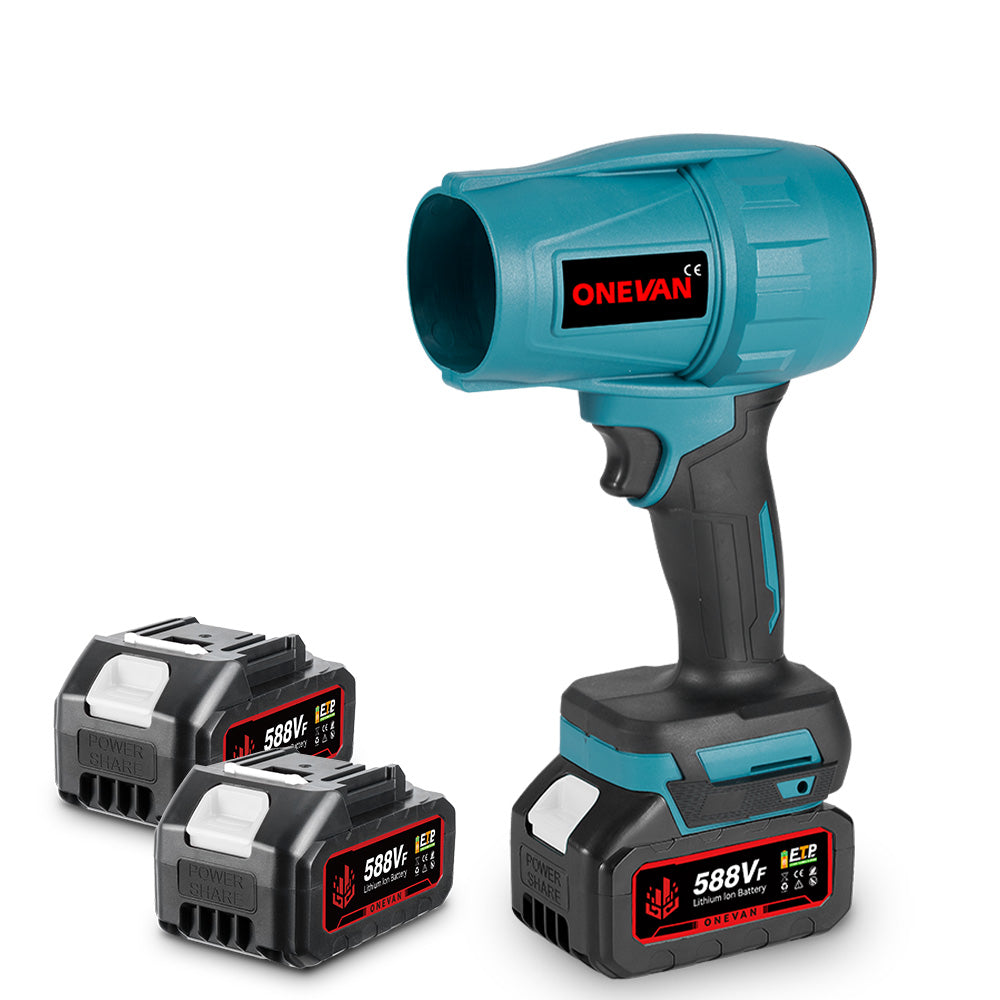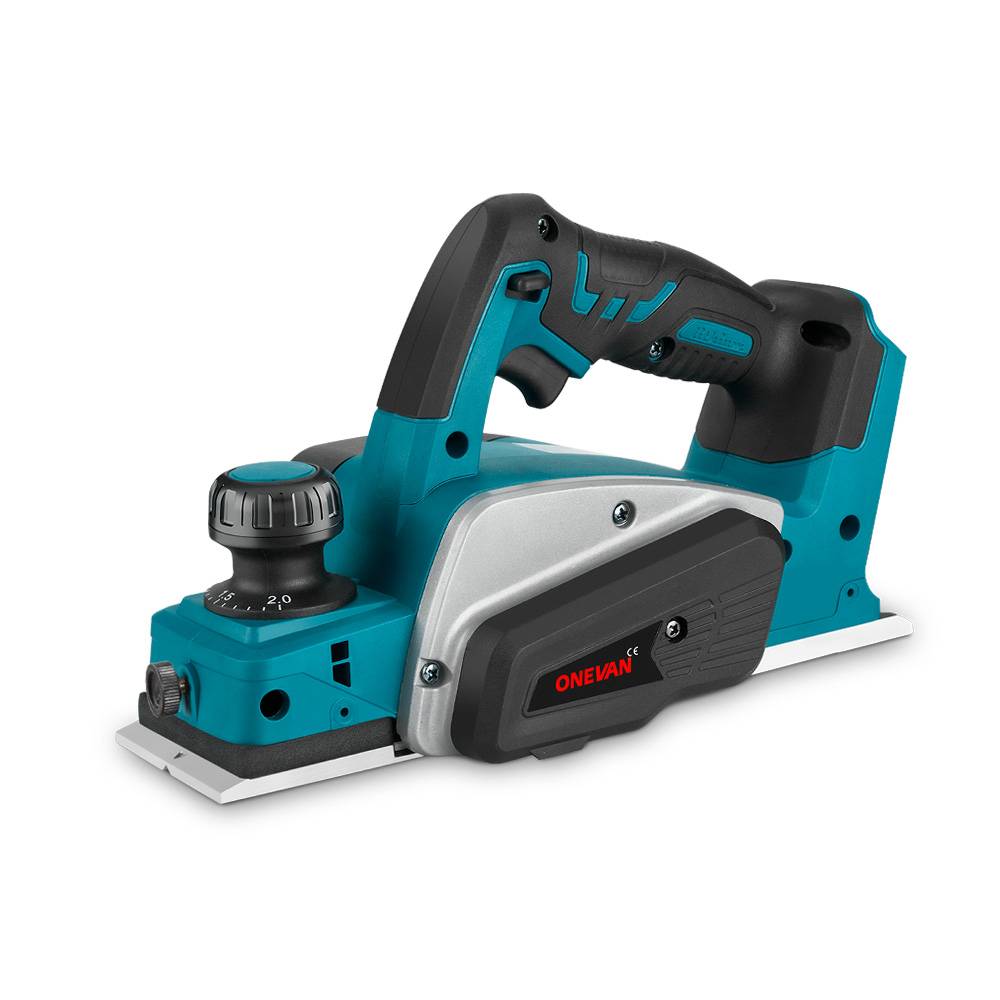However, if you learn these grinding tricks, you can effortlessly make smooth and level surfaces.
So, what are you going to learn in this precise guide?
Here are the key takeaways:
- Selecting the right angle grinder
- Safety precautions
- The grinding process step-by-step
- Troubleshooting common issues
1. Selecting the Right Angle Grinder For Concrete Grinding
Select a robust angle grinder designed for professional use, ideally with a 7-amp motor or higher. These tools are tough, and you'll be putting them through hell, so don't skimp.
Also read: How do you use an angle grinder to cut the metal?
Types of Angle Grinders for Concrete Grinding

There are two types of angle grinders for concrete grinding:
- Cordless angle grinder
- Corded angle grinder
Both have pros and cons. However, a cordless angle grinder gives you freedom of movement. On the other hand, a corded angle grinder runs on a continuous power supply, which restricts the operator's movement.
Types of Grinding Discs Suitable for Concrete Grinding
There are two major types of grinding discs:
1. Diamond discs
2. Metal Grinding discs
Diamond discs are the preferred choice for concrete grinding, as metal grinding discs are not effective and can be a waste of time and money. They'll burn up before you get anything done. Diamond discs come in different grits, so pick one that matches the job. Coarse for rough removal and fine for finishing.
The Disc Grit Size Suitable for Concrete Grinding
The grit on the diamond disc matters. A coarse grit will chew through concrete swiftly. However, the chances of a rough surface will be higher. Therefore, use fine grit to give a smoother finish. Subsequently, you can start with a coarse disc and finish with a finer tone for the best results.
2. Step-By-Step Guide To Grinding Concrete With A Cordless Angle Grinder
How to grind concrete with angle grinder? I will share detailed steps for you to understand how to grind concrete with an angle grinder below.

Step 1: Gear Up
Begin by gathering your tools. Ensure you have a robust cordless angle grinder, such as ONEVAN 76mm Cordless Angle Grinder. Make sure the battery’s charged, and have a spare ready. Select a diamond grinding disc with an adequate size. Subsequently, don’t overlook safety gear: goggles, dust masks, earplugs, and gloves are musts. Knee pads are optional but can save your knees.
Step 2: Prep the Area
Clear the space, open windows if you can, and mark the area you’re grinding. This helps you stay focused and avoid mistakes.
Step 3: Suit Up
Do not underestimate this step. Goggles are basic safety equipment in grinding tasks and are essential for protecting your eyes. For example, they can help you to protect your eyes from flying debris, the mask keeps dust out of your lungs, earplugs save your hearing, and gloves protect your hands.
Step 4: Mount the Disc
Turn off the grinder, remove the battery, and lock the spindle. This will stop it from moving. Now, put on the grinding disc tightly. Make sure it's very secure. A loose disc is dangerous.
Step 5: Hook Up the Dust Catcher (Optional)
If you’re using one, attach the dust shroud and connect the vacuum. This thing makes a huge difference in keeping the mess down.
Step 6: Power Up
Put the battery into the grinder. Make sure it clicks in securely. Then, hold the grinder firmly with both hands. One hand should be on the main handle, and the other on the side handle. Find the power button or trigger. Gently squeeze it to turn on the grinder.
Step 7: Start Grinding
Get a good grip on the grinder. Start grinding using steady pressure. Don’t force it; let the grinder do the work. Overlap your passes for a smooth finish.
Step 8: Manage the Dust
Grinding makes a lot of dust. If you have a vacuum, use it to suck up the dust. Stop grinding for a bit to clean up the mess. You can use a wet rag to wipe away the dust too.
Step 9: Watch The Battery
cordless angle grinder offer convenience, but it's important to monitor battery life. Pay attention to how much battery power is left. Keep an extra battery to avoid any unexpected battery problems in a cordless angle grinder.
Step 10: Check Your Work
Stop grinding for a minute and look at the concrete. Is it smooth enough? If not, change how you're holding the grinder or the way you're moving it. You might need to use a different grinding disc. A finer disk will make the surface smoother.
Step 11: Wrap It Up
Turn off the grinder, remove the battery, and let it cool before cleaning up the work area.
Step 12: Take Care of Your Gear
Inspect the disc for damage. Check the grinder for wear. Charge the batteries. Store everything properly.
Remember, safety first. Wear your gear, and take your time. With a little practice, you’ll be grinding like a pro.
3. Common Issues and Solutions for Grind Concrete with an Angle Grinder
Grinding concrete for a beginner is a challenging task. You can encounter several unexpected issues. So in this section below, you will read the basic issues and the quick solutions.
Uneven Grinding or Gouging
This usually occurs when you press too hard, the disc is worn, or the grinder is held at an incorrect angle. Lighten up on the pressure, check the disc, and keep the grinder flat.
Grinder Overheating
Overheating is a killer. It can ruin your grinder. Take breaks, and let it cool. If it's overheating a lot, you might be pushing it too hard or the motor's shot.
Dust Everywhere
Dust is a pain. Use a dust shroud and vacuum if you can. Wear a good mask. If dust is clogging everything, stop, and clean it out.
Battery Dying Too Fast
Cordless grinders are very useful power tools, but you may face battery issues sometime. It's a good idea to have an extra battery ready to use. Don't overwork the grinder, or the battery will die even faster.
Grinder Stalling
Stalling usually means you're overloading the grinder. If your grinder suddenly stops working, it's probably because you're putting too much pressure. The grinder is overloaded. Try using a more powerful grinder or a grinding disc that's better suited for the job.
Can't Control the Grinder
A loose grip or a worn grinder can cause this. Hold the grinder tightly with both hands. Check if the parts that help the grinder spin smoothly (bearings) are worn out. If they are, you need to repair the grinder.
Sparks and Noise
Sparks and noise aren't normal. Minutely check the grinding disc for any damage, such as cracks or chips. Further, ensure that every part of the grinder is tightened well. In case you notice sparks or hear unfamiliar sounds, desist from continuing to use the machine and examine it closely.
Grinding Too Slow
Worn disc, wrong disc, or a weak grinder. The grinding disc could be worn out or the wrong type for the job. Maybe the grinder itself isn't powerful enough. Check the disc and try a different one. If that doesn't help, you might need a stronger grinder.
Vibration and Discomfort
Vibration is normal, but too much is bad. Check if the grinder is balanced correctly. Make sure all the parts are tightened properly. If the vibration is still strong, stop using the grinder and check it for damage.
Ruined Concrete
This happens. If you dig in too deep. Once you've damaged the concrete, there's not much you can do to fix it. That's why it's important to be careful and take your time when grinding.
4. Conclusion
Grinding concrete is not hard. You need the right tools. Wear safety stuff. Follow the steps. You might have problems. Dust is bad. The grinder can get hot. Be careful not to mess up the concrete. If you do it right, your concrete will look good. Always be safe.
5.FAQs
1. How to grind cement smoothly?
Installing a diamond grinding disc in your angle grinder simplifies achieving a smooth surface. The first step is to start with a coarser grit disc. It will significantly remove irregular surface patterns, then switch to a finer grit for a smoother finish. Overlapping your passes and maintaining consistent pressure will also help create a uniform look.
2. Should I wet concrete before grinding?
Wet concrete before grinding is generally not recommended. Dry grinding is often more efficient and produces less mess. However, in some cases, like removing epoxy coatings, wetting the concrete can help. Always test a small area first to see if it improves the grinding process.
3. Can concrete be too hard to grind?
Yes, concrete can be too hard to grind. Older or higher-strength concrete may require particular devices or procedures. When your angle grinder faces difficulty in cutting through something, it means that it is not suitable for doing the job. In case you find your grinder is not working well as required, consider renting or hiring a more powerful grinder designed for heavy-duty concrete removal.
4. How far down can you grind concrete?
The depth you have the ability to grind depends on how thick is your concrete slab and what do you want achieve. Often, an angle grinder can be used to eliminate about 1/8 – ¼ inch of concrete. For greater removal of material, use a floor grinder. Always avoid grinding through your entire slab.
5. How long should concrete cure before grinding?
Concrete should be fully cured before grinding. This typically takes around 28 days. Grinding prematurely can weaken the concrete and affect its durability.
6. What type of grinder is best for concrete?
An angle grinder is suitable for small areas or making minor adjustments. For larger surfaces and more aggressive grinding, a floor grinder is the better choice. Both types require diamond grinding discs for effective concrete removal.
7. How do you grind concrete fast?
To grind concrete quickly, use a powerful angle grinder with a coarse diamond disc. Apply steady pressure and maintain a consistent speed. However, prioritize safety over speed. Grinding too fast can lead to uneven results, damage to the grinder, and increased dust production.
8. How to use angle grinder to cut concrete?
To cut concrete with an angle grinder, you need a special diamond cutting blade. These blades are designed for cutting through concrete. Make sure the blade is securely attached to the grinder. Wear safety gear like goggles, gloves, and a dust mask. Start the cut slowly. Let the blade do the work. Be careful not to overload the grinder.
9. What angle grinder disc for concrete?
You need a special disc called a diamond grinding disc. This disc is made for cutting through hard stuff like concrete.
It's different from the discs you use for metal. Diamond discs come in different sizes and grit levels. The grit number tells you how rough or fine the disc is. Lower number ignifies the rough disc, while a higher number means it's good to carry.
However, it is crucial to install the suitable size disc for your angle grinder. You also need to choose the right grit based on what you're doing. If you're trying to remove a lot of concrete, use a rougher disc. If you want a smooth finish, use a finer one.
10. Can you polish concrete with an angle grinder?
Yes, you can polish concrete with an angle grinder. You'll need special polishing pads instead of grinding discs. Start with a rough pad to smooth the concrete. The next step is to use finer pads. These pads will deliver a shiny finish. It's hard work and takes time, but you can make your concrete floor look really nice.
Tags: how to grind concrete with angle grinder, how to grind concrete with an angle grinder, cordless angle grinder

